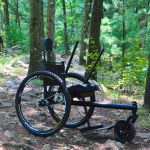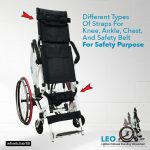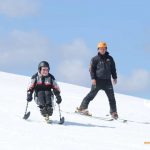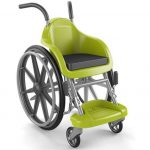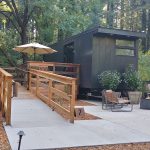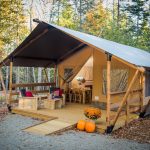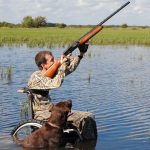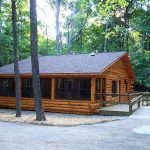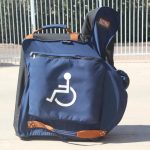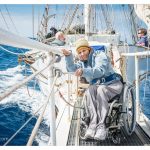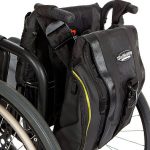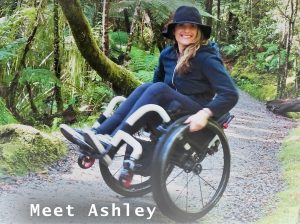Standard wheelchairs are meant to aid disabled individuals in the most basic of everyday tasks. They can easily and quickly topple on rocky roads, just like they would get stuck in sand or some cases even wet dirt. Fortunately, the numerous technological advancements in this field gave birth to various gadgets and uniquely designed wheelchairs that can traverse rougher types of terrain. If you’ve been disabled from birth and always wanted to enjoy a warm beach day, or if you’ve become disabled and want to camp with your friends again, stick with us for a while longer as we discuss how to handle rough terrain with a wheelchair.
All-Terrain Wheelchairs
Essentially, all-terrain wheelchairs are exactly what the term sounds like – the wheelchair models that were heavily modified with thicker, wider tires, sturdier construction, and vastly improved stability. They can handle all forms of both terrain and weather, be it smoldering hot sand, windy and rocky roads, or knee-deep snow. However, the more versatile they are, the less suitable they would be for use in extreme conditions. For instance, wheelchairs with waterproof tires and construction won’t rust in snowy steeps, but they may get stuck.
One of the finest all-terrain wheelchairs of today is the famous Freedom Chair developed by GRIT, which is a foldable, lightweight, robust wheelchair developed by MIT engineers. It’s an excellent choice for disabled people who want to be able to enjoy any outdoor activity, regardless of the weather. The main downside of all-purpose all-terrain wheelchairs is that they don’t excel in handling extreme colds, the deepest snow, and the beaches with the thinnest sand.
Snow Wheelchairs
Snow wheelchairs are often supplied with high-impact motors, which means that such models aren’t exactly recommended for use in water. Furthermore, they’re also often designed with a wider seat that can spread the user’s weight over wider surfaces, which prevents sinking into the snow. They’re commonly equipped with pneumatic tires or knobby treats that can safely and easily tackle any winter challenge. Living Spinal offers a broad catalog of snow wheelchair mods that you may want to consider if you’re already happy with the model you have. Modifying a sturdy, reliable wheelchair for wintertime trips is usually cheaper than buying a brand-new one with very narrow-sighted specs.
Beach Wheelchairs
The biggest obstacle for wheelchairs on beaches is sand. Treaded tires are more likely to dig into the sand rather than pass through it, which essentially means that winter wheelchairs would be the least favorable option here. Beach wheelchairs typically feature massive, rounded tires that are capable of gliding over the sand as opposed to plowing through it. They’re mostly made of fully waterproof materials, and their tires are often constructed of lightweight plastic. If you’re buying a new wheelchair for use on sandy terrains, it’s also very important to have a good set of brakes. CadWeazle is a beach wheelchair that resembles a small battery-powered ATV that can be molded with anything from balloon wheels to a hood-mounted solar panel.
Forest/Countryside Wheelchairs
Forests aren’t as harsh of terrain as a snowy slope can be, but they’re rough in comparison to slated concrete. There are numerous obstacles to worry about, such as branches, twigs, small animals, and obviously, rocks. A forest wheelchair needs to be as sturdy as possible due to the thousands of small impact shocks the tires are bound to endure. Speaking of which, the tires of a countryside wheelchair need to be treated and wide enough to pass over any kind of obstacle. Reliable brakes are mandatory, as you never know when you may encounter a wild rabbit or a squirrel crossing your path. Modifications-wise, you should focus on stability improvements, most notably on additional sets of wheels. The Forest 3 is one of the most versatile off-road wheelchairs that packs exceptionally responsive brakes, incredibly rugged tires, and a highly customizable seat.
Off-Road Mountain Trikes
While all-terrain wheelchairs are well-rounded and perform better than conventional models in all fields, mountain trikes are more specialized designs meant to tackle an otherwise non-traversable terrain. Mountain trikes are supplied with two additional sets of smaller wheels (one set front and one set back) that make toppling virtually impossible. Just like all-terrain models, trikes feature wider and thicker tires that make them perform equally great on sand, dirt, snow, and concrete.
However, the construction of a mountain trike is bulkier and they weigh considerably more in comparison to their all-terrain counterparts. They’re also a bit harder to assemble, but fortunately, these are their only shortcomings. The main benefit of a mountain trike is nearly unparalleled movement control. Even the cheapest entry-level models are outfitted with highly responsive brake systems that are on par with boutique mountain bikes. Additionally, mountain trikes also boast increased shock absorption, which means that they’re also excellent for commuting.
Electric Powered Wheelchairs
The equivalent of quad bikes for disabled people is the electric-powered wheelchair. A power wheelchair can move much faster than a regular, manual wheelchair because of the motors that offer enhanced torque. Perhaps more importantly, power wheelchairs feature a driving mechanism that is similar to off-road four-wheelers (the all-wheel-drive system). Power wheelchairs such as these are capable of ascending sharp-angled slopes and most are exceptionally modifiable.
However, electric-powered wheelchairs aren’t well-suited for beaches and can malfunction when exposed to larger quantities of water. In comparison to off-road trikes, electric wheelchairs are slightly less stable, even when outfitted with extra wheels and tires. Their main benefits are faster riding, and the ability to traverse slopes and climb hills while boasting a similar level of versatility to all-terrain wheelchairs. Porto Mobility Ranger D09 is a terrific example of a quality electric wheelchair. It sports two batteries, a strong motor, and a foldable design.
Wheelchair Accessories
The market of wheelchair accessories is vast, and it’s comprised of features that can improve everything and anything from comfort, stability, and speed, to granting additional functionalities to your wheelchair. Padded seat cushions and armrests, for example, aren’t just comfort features; they are meant to negate the amount of shock that the tires weren’t able to fully absorb. Grabbers and other reaching mechanisms are meant to help disabled people collect fruits, stones, leaves, rocks, and pretty much any object from the ground that is otherwise unreachable.
Even though classic camping equipment such as backpacks can’t be considered wheelchair accessories, these can be of tremendous help on an outdoor trip too. Plus, there are bags made just for wheelchairs. Fishing pole holders are popular among anglers and can be very useful for traveling, especially given that larger and more customizable models can double as bottle holders. The anti-tippers are, by far, among the most valuable rough-terrain wheelchair adjustments that provide extra stability and are meant to work in synergy with extra wheels and tires, regardless of where these were installed. Anti-rollback systems aren’t compatible with most electric-powered wheelchairs, although these adjustments are naturally great for forests, hills, slopes, and similar types of terrain. Finally, you should consider a tall-push handlebar if you’re a camper, as this feature leaves the back of your wheelchair completely free for even the largest of backpacks.


